Influence of Loading Distance, Loading Angle and Log Orientation on Time Consumption of Forwarder Loading Cycles: A Pilot Case Study
Abstract
:1. Introduction
2. Materials and Methods
2.1. Machine
2.2. Study Setup
2.3. Elemental Time Study and Operator
2.4. Statistical Analysis
3. Results
3.1. Influence of Loading Angle on Time Consumption Per Loading Cycle
3.2. Influence of Log Orientation on Time Consumption Per Loading Cycle
3.3. Influence of Loading Distance on Time Consumption Per Loading Cycle
3.4. Increase of Time Consumption Per Loading Cycle According to Test Settings
4. Discussion
4.1. Methodology
4.2. Influence of Loading Angle on Time Consumption
4.3. Influence of Log Orientation Angle on Time Consumption
4.4. Influence of Loading Distance on Time Consumption
5. Conclusions
- The time consumption per loading cycle increases with a higher loading angle;
- An increasing log orientation angle leads to increasing cycle times while loading;
- The loading distance affects time consumption per loading cycle, interacting with loading angle and log orientation angle.
Author Contributions
Funding
Institutional Review Board Statement
Informed Consent Statement
Data Availability Statement
Acknowledgments
Conflicts of Interest
References
- Nurminen, T.; Korpunen, H.; Uusitalo, J. Time Consumption Analysis of the Mechanized Cut-to-length Harvesting System. Silva Fenn. 2006, 40, 335–363. [Google Scholar] [CrossRef] [Green Version]
- Dvorak, J.; Malkowsky, Z.; Macku, J. Influence of Human Factor on the Time of Work Stages of Harvesters and Crane-Equipped Forwarders. J. For. Sci. 2008, 54, 24–30. Available online: https://www.agriculturejournals.cz/publicFiles/00625.pdf (accessed on 12 February 2022). [CrossRef] [Green Version]
- Axelsson, S. The Mechanization of Logging Operations in Sweden and its Effect on Occupational Safety and Health. Int. J. For. Eng. 2013, 9, 25–31. Available online: https://www.tandfonline.com/doi/abs/10.1080/08435243.1998.10702715 (accessed on 12 February 2022).
- Kuratorium für Waldarbeit und Forsttechnik e.V. (KWF). Lastenheft Harvestervermessung; Kuratorium für Waldarbeit und Forsttechnik e.V. (KWF): Gross-Umstadt, Germany, 2010; p. 4, KWF-Bericht Nr. 41/2010; Available online: https://www.landesforsten.de/wp-content/uploads/2018/06/lastenheft_harvestervermessung_nds.pdf (accessed on 12 January 2022).
- Bayerische Staatsforsten AöR. Maschinen; Bayerische Staatsforsten AöR: Regensburg, Germany; 1, Available online: https://www.baysf.de/de/wald-bewirtschaften/holzernte/maschinen.html (accessed on 12 January 2022).
- Karjalainen, T.; Zimmer, B.; Berg, S.; Welling, J.; Schwaiger, H.; Finer, L.; Cortijo, P. Energy, Carbon and Other Material Flows in the Life Cycle Assessment of Forestry and Forest Products: Achievements of the Working Group 1 of the COST Action E9; European Forest Institute: Joensuu, Finland, 2001; pp. 43; discussion Paper 10. Available online: https://efi.int/sites/default/files/files/publication-bank/2018/dp_10.pdf (accessed on 12 February 2022).
- Hoffmann, S.; Jaeger, D. Insights on motor-manual tree felling in Germany, recent developments to ensure efficient operations in singletree selection harvest. Eur. J. For. Eng. 2021, 7, 39–44. [Google Scholar] [CrossRef]
- Spinelli, R.; Owende, P.M.O.; Ward, S.M.; Tornero, M. Comparison of short-wood forwarding systems used in Iberia. Silva Fenn. 2004, 1, 85–94. [Google Scholar] [CrossRef] [Green Version]
- Väätäinen, K.; Ala-Fossi, A.; Nuutinen, Y.; Röser, D. The Effect of Single Grip Harvester´s Log Bunching on Forwarder Efficiency. Balt. For. 2006, 12, 64–69. [Google Scholar] [CrossRef] [Green Version]
- Mederski, P.S.; Bembenek, M.; Karaszewski, Z.; Lacka, A.; Szczepanska-Alvarez, A.; Rosinska, M. Estimating and Modelling Harvester Productivity in Pine Stands of Different Ages, Densities and Thinning Intensities. Croat. J. For. Eng. 2016, 37, 27–36. Available online: https://www.researchgate.net/publication/295092085_Estimating_and_Modelling_Harvester_Productivity_in_Pine_Stands_of_Different_Ages_Densities_and_Thinning_Intensities (accessed on 12 January 2022).
- Tervo, K.; Palmroth, L.; Koivo, H.N. Skill Evaluation of Human Operators in Partly Automated Mobile Working Machines. IEEE Trans. Autom. Sci. Eng. 2010, 7, 133–142. [Google Scholar] [CrossRef]
- Palmroth, L. Performance Monitoring and Operator Assistance Systems in Mobile Machines. Ph.D. Thesis, Tampere University of Technology, Tampere, Finland, 2011. Available online: https://trepo.tuni.fi//handle/10024/115054 (accessed on 12 February 2022).
- Purfürst, T.; Lindroos, O. The Correlation between Long-Term Productivity and Short-Term Performance Ratings of Harvester Operators. Croat. J. For. Eng. 2011, 32, 509–519. Available online: https://www.researchgate.net/publication/265525765_The_Correlation_between_Long-Term_Productivity_and_Short-Term_Performance_Ratings_of_Harvester_Operators (accessed on 12 February 2022).
- Manner, J. What is (not) an operator effect in forest work science? Silva Fenn. 2021, 55, 1–4. [Google Scholar] [CrossRef]
- Manner, J.; Nordfjell, T.; Lindroos, O. Effects of the number of assortments and log concentration on time consumption of forwarding. Silva Fenn. 2013, 47, 1–19. [Google Scholar] [CrossRef] [Green Version]
- Proto, A.R.; Macri, G.; Visser, R.; Harrill, H.; Russo, D.; Zimbalatti, G. A Case Study on the Productivity of Forwarder Extraction in Small-Scale Southern Italian Forests. Small-Scale For. 2018, 17, 71–87. [Google Scholar] [CrossRef]
- Acuna, M.A.; Kellogg, L.D. Evaluation of Alternative Cut-to-Length Harvesting Technology for Native Forest Thinning in Australia. Int. J. For. Eng. 2009, 20, 17–25. [Google Scholar] [CrossRef]
- Gingras, J.F.; Favreau, J. Effect of Log Length and Number of Products on the Productivity of Cut-to-Length Harvesting in the Boreal Forest. Advantage 2005, 6, 1–8. Available online: https://fgr.nz/documents/download/4728 (accessed on 12 February 2022).
- Bodelschwingh, E.V. Analyse der Rundholzlogistik in der Deutschen Forst- und Holzwirtschaft—Ansätze für ein Übergreifendes Supply Chain Management. Ph.D. Thesis, Technische Universität München, Munich, Germany, 2005. Lehrstuhl für Forstliche Arbeitswissenschaft und Angewandte Informatik, Freising. Available online: https://mediatum.ub.tum.de/doc/603713/file.pdf (accessed on 12 January 2022).
- Eriksson, M.; Lindroos, O. Productivity of harvesters and forwarders in CTL operations in northern Sweden based on large follow-up datasets. Int. J. For. Eng. 2014, 25, 179–200. [Google Scholar] [CrossRef]
- Ghaffarian, M.R.; Stampfer, K.; Sessions, J. Forwarding Productivity in Southern Austria. Croat. J. For. Eng. 2007, 28, 169–175. Available online: http://www.crojfe.com/site/assets/files/3894/reza-1.pdf (accessed on 12 February 2022).
- Strandgard, M.; Mitchell, R.; Acuna, M. Impact of Slope on Forwarder Load Size and Productivity. In Proceedings of the 48th FORMEC Symposium, Linz, Austria, 1 December 2015; pp. 101–105. Available online: https://www.formec.org/images/proceedings/2015/formec_proceedings_2015_web.pdf (accessed on 12 January 2022).
- Tiernan, D.; Zeleke, G.; Owende, P.M.O.; Kanali, C.L.; Lyons, J.; Ward, S.M. Effect of Working Conditions on Forwarder Productivity in Cut-to-length Timber Harvesting on Sensitive Forest Sites in Ireland. Biosyst. Eng. 2004, 87, 167–177. [Google Scholar] [CrossRef]
- Zimbalatti, G.; Proto, A.R. Productivity of Forwarders in South Italy. In Proceedings of the 44th FORMEC Symposium, Padova, Italy, 11–14 July 2010; Available online: https://www.formec.org/proceedings/27-italy-2010-proceedings.html (accessed on 12 January 2022).
- Stankic, I.; Porsinsky, T.; Tomasic, Z.; Tonkovic, I.; Frntic, M. Productivity Models for Operational Planning of Timber Forwarding in Croatia. Croat. J. For. Eng. 2012, 33, 61–78. Available online: https://www.researchgate.net/publication/298433002_Productivity_Models_for_Operational_Planning_of_Timber_Forwarding_in_Croatia (accessed on 12 February 2022).
- Gerasimov, Y.; Senkin, V.; Väätäinen, K. Productivity of single-grip harvesters in clear-cutting operations in the northern European part of Russia. Eur. J. For. Res. 2012, 131, 647–654. [Google Scholar] [CrossRef]
- Eliasson, L.; Grönlund, Ö.; Lundström, H.; Sonesson, J. Harvester and forwarder productivity and net revenues in patch cutting. Int. J. For. Eng. 2020, 32, 3–10. [Google Scholar] [CrossRef]
- Kovac, J.; Tavoda, P.; Harvanek, P.; Krilek, J.; Ales, Z. The Operational Reliability Analysis of Machinery: A Case Study of Forest Forwarders and Their Technological Equipment. Forests 2021, 12, 404. [Google Scholar] [CrossRef]
- Holzfeind, T.; Stampfer, K.; Holzleitner, F. Productivity, setup time and costs of a winch-assisted forwarder. J. For. Res. 2018, 23, 196–203. [Google Scholar] [CrossRef]
- Manner, J.; Palmroth, L.; Nordfjell, T.; Lindroos, O. Load level forwarding work element analysis based on automatic follow-up data. Silva Fenn. 2016, 50, 1–19. [Google Scholar] [CrossRef] [Green Version]
- Ovaskainen, H.; Palander, T.; Tikkanen, L.; Hirvonen, H.; Ronkainen, P. Productivity of Different Working Techniques in Thinning and Clear Cutting in a Harvester Simulator. Balt. For. 2011, 17, 288–298. Available online: https://www.researchgate.net/publication/261366042_Productivity_of_Different_Working_Techniques_in_Thinning_and_Clear_Cutting_in_a_Harvester_Simulator (accessed on 14 February 2022).
- R Core Team. R: A Language and Environment for Statistical Computing; The R Foundation for Statistical Computing: Vienna, Austria, 2020. [Google Scholar]
- Geiger, C.; Beiser, S.; Geimer, M. Automated Driving on a Skid Road with a Forwarder in a CTL Logging Process. In Proceedings of the Joint 43rd Annual Meeting of Council on Forest Engineering (COFE) & The 53rd International Symposium on Forest Mechanization (FORMEC), Corvallis, OR, USA, 27–30 September 2021; pp. 5–7. Available online: https://cofe.org/pdfs/COFE-FORMEC2021.pdf (accessed on 13 February 2022).
- Ovaskainen, H. Comparison of Harvester Work in Forest and Simulator Environments. Silva Fenn. 2005, 39, 89–101. [Google Scholar] [CrossRef] [Green Version]
- Jacke, H.; Wagner, T. Einsichten aus einem virtuellen Wettbewerb Teil 2. Forst Und Tech. 2002, 3, 4–9. [Google Scholar]
- Lamminen, S.; Väätäinen, K.; Asikainen, A. The Importance of the Forwarder Operator in Loading Phase during Virtual CTL-Forwarding. In Proceedings of the 44th International Symposium on Forest Mechanization (FORMEC), Graz, Austria, 9–13 October 2011; Available online: https://www.formec.org/proceedings/25-austria-2011-proceedings.html (accessed on 12 February 2022).
- Manner, J.; Berg, S.; Englund, M.; Ersson, B.T.; Mörk, A. Innovative Productivity Improvements in Forest Operations: A Comparative Study of the Assortment Grapple Using a Machine Simulator. J. For. Sci. 2020, 66, 443–451. [Google Scholar] [CrossRef]
- Purfürst, T.; Erler, J. The Human Influence on Productivity in Harvester Operations. Int. J. For. Eng. 2011, 22, 15–22. [Google Scholar] [CrossRef]
- Jacke, H.; Wagner, T. Einsichten aus einem virtuellen Wettbewerb Teil 1. Forst Und Tech. 2001, 9, 4–7. [Google Scholar]
- Gellerstedt, S. Operation of the Single-Grip Harvester: Motor-Sensory and Cognitive Work. Int. J. For. Eng. 2002, 13, 35–47. [Google Scholar] [CrossRef]
- Ovaskainen, H.; Uusitalo, J.; Väätäinen, K. Characteristics and Significance of a Harvester Operators´Working Technique. Int. J. For. Eng. 2004, 15, 67–77. [Google Scholar] [CrossRef]
- Väätäinen, K.; Lamminen, S. The Impact of Forwarding Technique on Forwarding Output—A Case Study Based on The Ponsse Forwarder Game. In Proceedings of the Nordic Baltic Conference OSCAR14, Knivsta, Sweden, 25–27 June 2014; pp. 82–84. Available online: https://www.skogforsk.se/contentassets/5e2aa98205a5416899b20eafe6872ba9/proceedings-manuscript-oscar14.pdf (accessed on 12 January 2022).
- Proto, A.R.; Macri, G.; Visser, R.; Harrill, H.; Russo, D.; Zimbalatti, G. Factors affecting forwarder productivity. Eur. J. For. Res. 2018, 137, 143–151. Available online: https://link.springer.com/article/10.1007/s10342-017-1088-6 (accessed on 11 January 2022). [CrossRef]
- Gerasimov, Y.; Sokolov, A.; Karjalainen, T. GIS-Based Decision-Support Program for Planning and Analyzing Short-Wood Transport in Russia. Croat. J. For. Eng. 2008, 29, 163–175. Available online: http://www.crojfe.com/site/assets/files/3875/06-gerasimov.pdf (accessed on 14 February 2022).
- Häggström, C.; Lindroos, O. Human, technology, organization and environment—A human factors perspective on performance in forest harvesting. Int. J. For. Eng. 2016, 27, 67–78. [Google Scholar] [CrossRef]
- Spinelli, R.; Magagnotti, N.; Labelle, E.R. The Effect of New Silvicultural Trends on Mental Workload of Harvester Operators. Croat. J. For. Eng. 2017, 31, 1–13. [Google Scholar] [CrossRef] [Green Version]
- Lindroos, O.; La Hera, P.; Häggström, C. Drivers of Advances in Mechanized Timber Harvesting—A Selective Review of Technological Innovation. Croat. J. For. Eng. 2017, 38, 243–258. [Google Scholar]
- Müller, F.; Jaeger, D.; Hanewinkel, M. Digitization in wood supply—A review on how Industry 4.0 will change the forest value chain. Comput. Electron. Agric. 2019, 162, 206–218. [Google Scholar] [CrossRef]
- Manner, J.; Gelin, O.; Mörk, A.; Englund, M. Forwarder crane´s boom tip control system and beginner-level operators. Silva Fenn. 2017, 51, 1–10. [Google Scholar] [CrossRef] [Green Version]
- Manner, J.; Mörk, A.; Englund, M. Comparing forwarder boom-control systems based on an automatically recorded follow-up dataset. Silva Fenn. 2019, 53, 1–15. [Google Scholar] [CrossRef] [Green Version]
- John Deere. Intelligente Kransteuerung. Available online: https://www.deere.de/de/forstmaschinen/ibc/ (accessed on 12 January 2022).
- Komatsu Forest. Komatsu Smart Crane. Available online: https://www.komatsuforest.de/entdecken/komatsu-smart-crane (accessed on 12 January 2022).
- Ponsse. Active Crane. Available online: https://www.ponsse.com/de/produkte/individuelle-losungen/produkte/-/p/activecranebisonbuffaloelephant#/ (accessed on 12 January 2022).
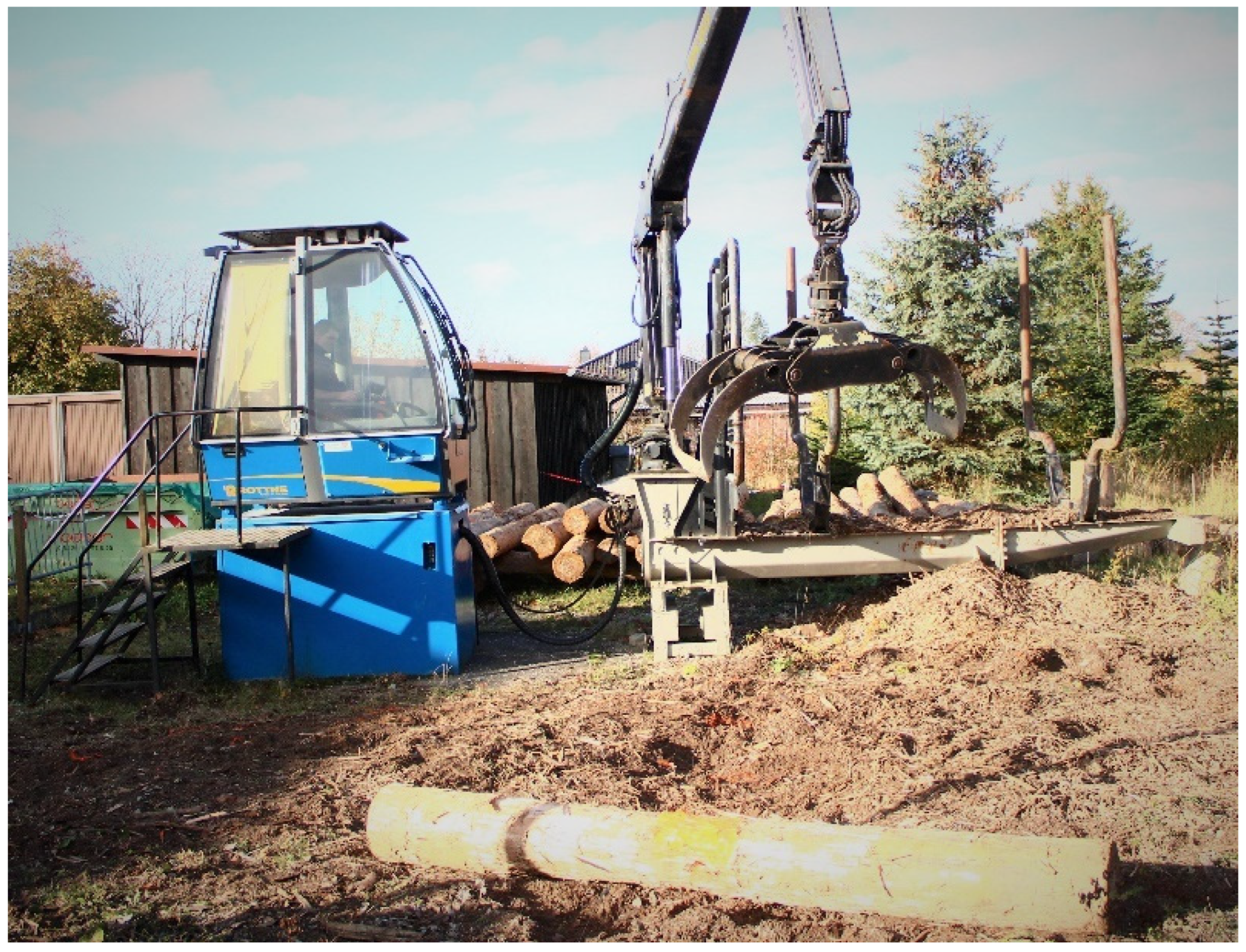
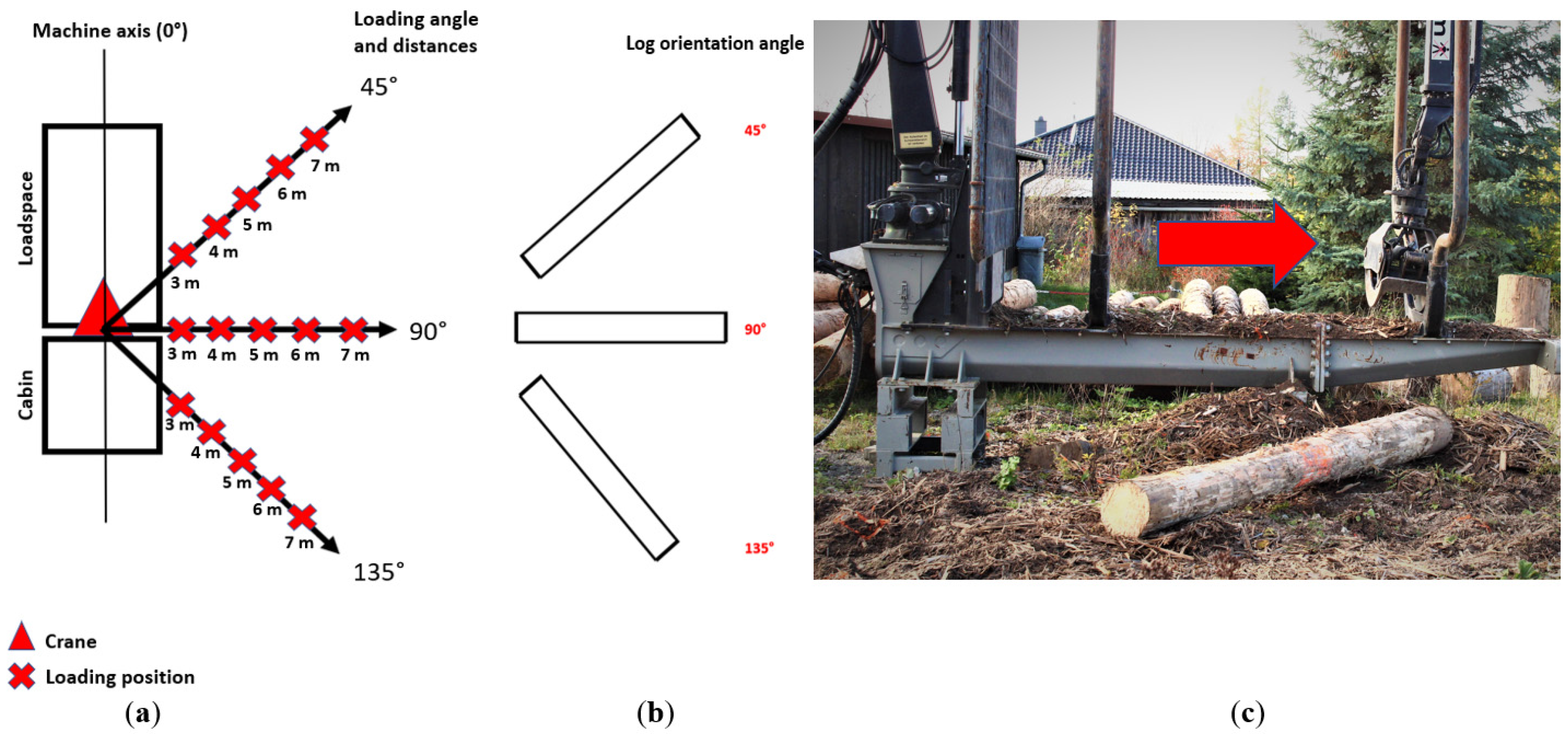
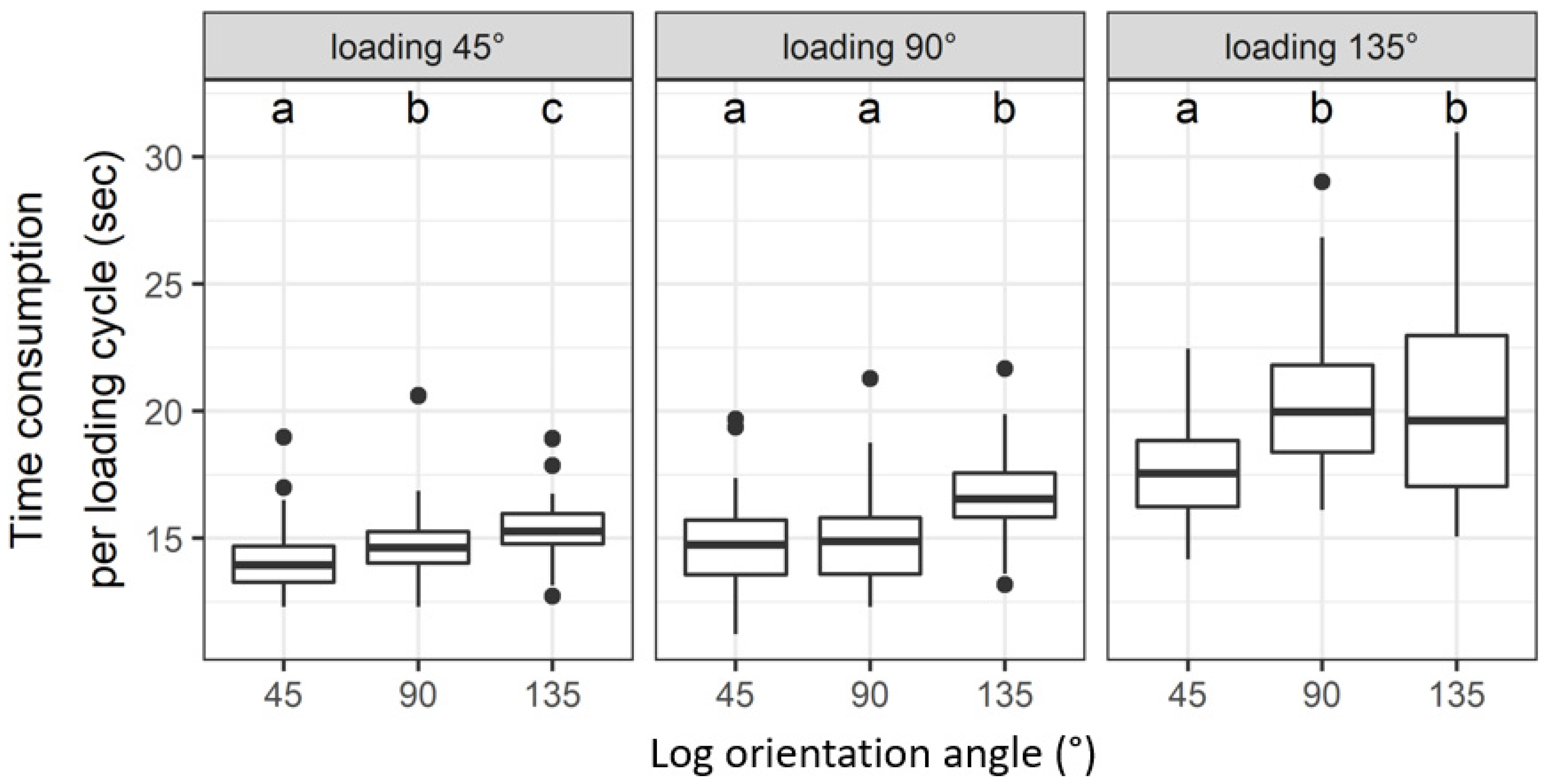
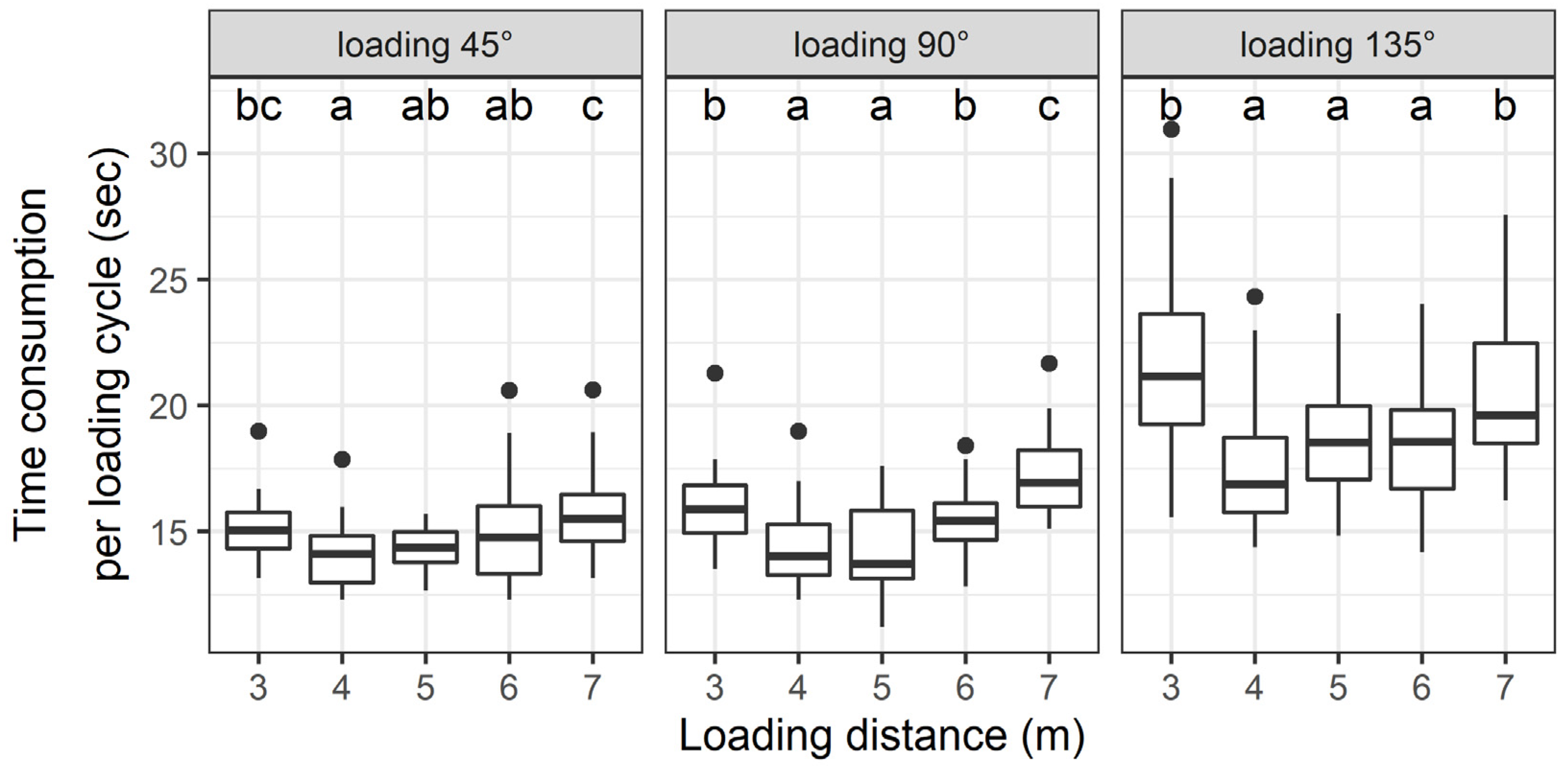
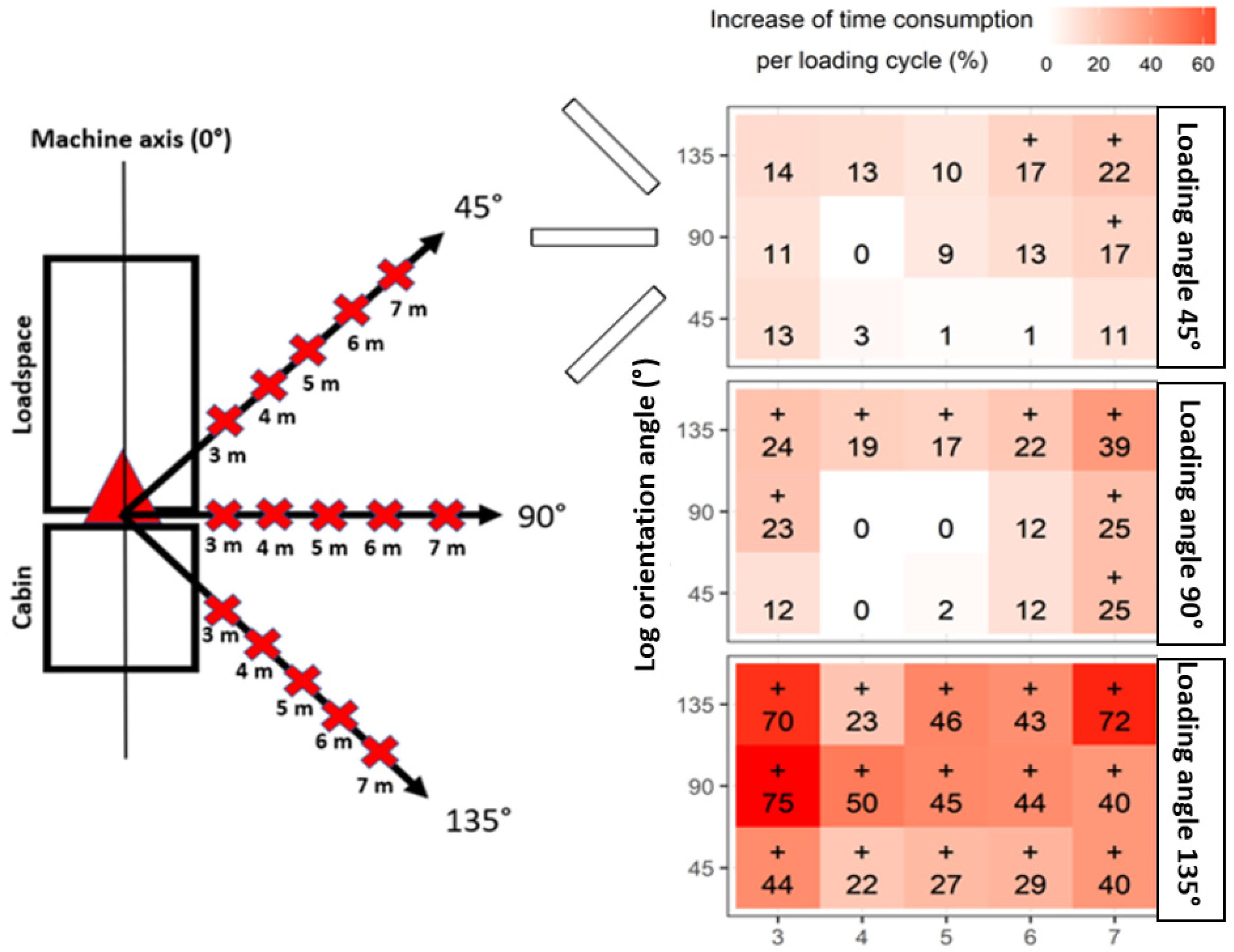
| Crane Type | RK 85 |
|---|---|
| Maximum reach | 7.5 m |
| Lifting torque, gross | 86.7 kNm |
| Lifting capacity at 7.5 m | 730 kg |
| Lifting capacity at 4.0 m | 1490 kg |
| Slewing torque | 27.1 kNm |
| Angle of rotation | 380° |
| Tractive force | 18 kN |
| numDF | F-Value | p-Value | |
|---|---|---|---|
| (Intercept) | 1 | 60,436.19 | <0.001 |
| L. Angle | 2 | 357.59 | <0.001 |
| L. Distance | 4 | 47.17 | <0.001 |
| Log Orientation | 2 | 56.31 | <0.001 |
| L. Angle: L. Distance | 8 | 4.79 | <0.001 |
| L. Angle: L. Orientation | 4 | 7.22 | <0.001 |
| L. Distance: Log Orientation | 8 | 1.33 | 0.225 |
| L. Angle: L. Distance: Log Orientation | 16 | 3.71 | <0.001 |
| Loading Angle [°] | Estimated Mean Time Consumption | SE | df | Lower CL | Upper CL | Group |
|---|---|---|---|---|---|---|
| 45 | 14.6 | 0.094 | 405 | 14.5 | 14.8 | a |
| 90 | 15.3 | 0.102 | 405 | 15.1 | 15.5 | b |
| 135 | 19.0 | 0.157 | 405 | 18.7 | 19.3 | c |
| Log Orientation [°] | Estimated Mean Time Consumption | SEM | DF | Lower CL | Upper CL | Group |
|---|---|---|---|---|---|---|
| 45 | 15.3 | 0.102 | 405 | 15.1 | 15.5 | a |
| 90 | 16.1 | 0.114 | 405 | 15.9 | 16.3 | b |
| 135 | 17.0 | 0.126 | 405 | 16.7 | 17.2 | c |
| Loading Distance [m] | Estimated Mean Time Consumption | SE | df | Lower CL | Upper CL | Group |
|---|---|---|---|---|---|---|
| 3 | 17.0 | 0.163 | 405 | 16.7 | 17.3 | a |
| 4 | 15.0 | 0.128 | 405 | 14.8 | 15.3 | b |
| 5 | 15.4 | 0.133 | 405 | 15.1 | 15.6 | b |
| 6 | 15.9 | 0.143 | 405 | 15.6 | 16.2 | c |
| 7 | 17.4 | 0.170 | 405 | 17.0 | 17.7 | a |
Publisher’s Note: MDPI stays neutral with regard to jurisdictional claims in published maps and institutional affiliations. |
© 2022 by the authors. Licensee MDPI, Basel, Switzerland. This article is an open access article distributed under the terms and conditions of the Creative Commons Attribution (CC BY) license (https://creativecommons.org/licenses/by/4.0/).
Share and Cite
Hartsch, F.; Schönauer, M.; Breinig, L.; Jaeger, D. Influence of Loading Distance, Loading Angle and Log Orientation on Time Consumption of Forwarder Loading Cycles: A Pilot Case Study. Forests 2022, 13, 384. https://doi.org/10.3390/f13030384
Hartsch F, Schönauer M, Breinig L, Jaeger D. Influence of Loading Distance, Loading Angle and Log Orientation on Time Consumption of Forwarder Loading Cycles: A Pilot Case Study. Forests. 2022; 13(3):384. https://doi.org/10.3390/f13030384
Chicago/Turabian StyleHartsch, Florian, Marian Schönauer, Lorenz Breinig, and Dirk Jaeger. 2022. "Influence of Loading Distance, Loading Angle and Log Orientation on Time Consumption of Forwarder Loading Cycles: A Pilot Case Study" Forests 13, no. 3: 384. https://doi.org/10.3390/f13030384
APA StyleHartsch, F., Schönauer, M., Breinig, L., & Jaeger, D. (2022). Influence of Loading Distance, Loading Angle and Log Orientation on Time Consumption of Forwarder Loading Cycles: A Pilot Case Study. Forests, 13(3), 384. https://doi.org/10.3390/f13030384






